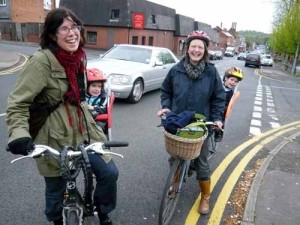By John Newson.
The public always say in surveys that it is “danger from traffic” that deters them from cycling – “especially in Birmingham”.
We have had a test of this for many years with the Rea Valley Cycle route. This uses Cannon Hill Park and other green spaces to get cyclists all the way into the city – largely protected from traffic. The result is truly impressive. Although it is used for leisure rides on Sundays, the route is actually busiest in the peak commuting times of Mon-Fri at 8-9am and 5-6pm. The Rea Valley is the opposite of an arterial road with its buses, lorries, bursts of traffic roaring away from the lights, and strings of engineered roundabouts. It should not be surprising that people’s behaviour is quite different – feeling safe, they ride bicycles.
In parts of Moseley and Balsall Heath, many streets are blocked off, as “no through roads”. This was done in the 1980s, to prevent kerb crawling by the customers of street prostitutes. Vehicles are few and don’t have a chance to get up speed. The result isn’t surprising – this is the area of the city with the most cyclists. Residents enjoy the peace and quiet, there are more pedestrians, children playing, songs of birds – everything that heavy traffic drives away has returned.
Last September, the Sky Ride closed off a line of streets one Sunday right into the city centre. What appeared were 15,000 cyclists. Brummies own bikes, they are just too scared to mix with traffic on them. Behaviour is rational and consistent. Cycling is cheap, healthy and enjoyable but the demand, as economists say, is suppressed.
The conclusion seems obvious. We cannot put in a complete system of cycle ways as well as the street network – there isn’t room and it would cost too much. Therefore, some parts of the street network have to lose their through-traffic function. They can be blocked off with tubs of flowers and wooden railings. It doesn’t have to cost much. They would admit vehicles to properties, just no through routes for traffic. For cyclists and walkers they would provide chains of safer streets running parallel to the ‘A’ roads and bus routes. As a matter of fact, the City Council’s Walking and Cycling Map has already drawn them in.
One can hear the highway engineers cry – you can’t do that, it’s a loss of highway capacity, where will we put all the traffic, there will be intolerable congestion etc.
This ignores the fact that a good proportion of journeys by car are actually really short ones. They could be walked or cycled, except that as we have said, these feel like unsafe and unattractive options. Provide safe cycling corridors and there will be substantial “modal shift” to bicycles which require less space than cars.
Birmingham isn’t particularly hilly or rainy. On such safer corridors, we could have the levels of cycling seen in north European cities, with enormous benefits. Women, children, teenagers, older people could cycle – it would no longer have the profile of a dangerous sport. They would get independent access to the city, instead of generating lots of short ‘taxi’ and ‘escort’ car journeys. The long exodus from Birmingham might be reversed, as you would no longer have to move out to find peace and quiet. Living near to work might return. People might find they didn’t need to own so many cars. Demotorisation could set in. Not bad for some strategically sited tubs of flowers….



